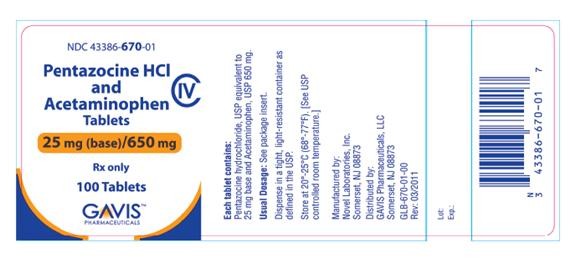
pentazocine/acetaminophen – oral, Talacen
Warning: Medication Uses, How To Use, Side Effects, Precautions, Drug Interactions, Overdose, Notes, Missed Dose, Storage WARNING: One ingredient in this product is acetaminophen. Taking too much acetaminophen may cause serious (possibly fatal) liver disease. Adults should not take more than 4000 milligrams of acetaminophen a day. If you have liver problems, consult your doctor or pharmacist for a safe dosage of this medication. Daily use of alcohol, especially when combined with acetaminophen, may increase your risk for liver damage. Avoid alcohol. Check with your doctor or pharmacist for more information. Get medical help right away if you have any symptoms of liver damage, including: dark urine, persistent nausea/vomiting, stomach/abdominal pain, extreme tiredness, or yellowing eyes/skin. Acetaminophen is an ingredient found in many nonprescription products and in some combination prescription medications. Carefully check the labels on all your medicines because they may also contain acetaminophen. Ask your pharmacist about using those products safely. Get medical help right away if you have taken more than 4000 milligrams of acetaminophen a day, even if you feel well. USES: This product is used to treat mild to moderate pain. It contains 2 medications, pentazocine and acetaminophen. Pentazocine is a narcotic pain reliever. Acetaminophen is a non-narcotic pain reliever. HOW TO USE: Take this medication by mouth with or without food, usually every 4 hours or as directed by your doctor. If you have nausea, it may help to take this drug with food. Consult your doctor or pharmacist about other ways to decrease nausea (such as taking antihistamines, lying down for 1 to 2 hours with as little head movement as possible). The dosage is based on your medical condition and response to treatment. Do not increase your dose, take the medication more frequently, or take it for a longer time than prescribed. Properly stop the medication when directed. Do not take more acetaminophen than recommended. (See also Warning sections). Pain medications work best if used when the first signs of pain occur. If you have been regularly using other narcotic pain medications, withdrawal reactions may occur when you start this product. Consult with your doctor or pharmacist for more details. This medication may cause withdrawal reactions, especially if used regularly for a long time or in high doses. In such cases, withdrawal symptoms may occur if you suddenly stop using this medication. To prevent withdrawal reactions, your doctor may reduce your dose gradually. Consult your doctor or pharmacist for more details, and report any withdrawal reactions immediately. When this medication is used for a long time, it may not work as well. Your doctor may need to increase your dose or change your medication. Talk with your doctor if this medication stops working well. This medication may rarely cause abnormal drug-seeking behavior. This risk may be increased if you have abused alcohol or drugs in the past. Take this medication exactly as prescribed to lessen the risk of addiction. Tell your doctor if your pain persists or worsens.
SIDE EFFECTS: See also Warning section. Nausea, vomiting, constipation, lightheadedness, dizziness, drowsiness, increased sweating, or dry mouth may occur. If any of these effects persist or worsen, tell your doctor or pharmacist promptly. To prevent constipation, maintain a diet adequate in fiber, drink plenty of water, and exercise. Consult your pharmacist for help in selecting a laxative (such as a stimulant type with stool softener). Remember that your doctor has prescribed this medication because he or she has judged that the benefit to you is greater than the risk of side effects. Many people using this medication do not have serious side effects. Tell your doctor right away if you have any serious side effects, including: mental/mood changes, difficulty urinating, vision changes, fast heartbeat, change in the amount of urine, signs of infection, easy bruising/bleeding. Get medical help right away if you have any very serious side effects, including: fainting, slow/shallow breathing, seizures. A very serious allergic reaction to this drug is rare. However, get medical help right away if you notice any symptoms of a serious allergic reaction, including: rash, itching/swelling, severe dizziness, trouble breathing. This is not a complete list of possible side effects. If you notice other effects not listed above, contact your doctor or pharmacist. In the US – Call your doctor for medical advice about side effects. In Canada – Call your doctor for medical advice about side effects. PRECAUTIONS: See also Warning section. Before taking this product, tell your doctor or pharmacist if you are allergic to pentazocine or acetaminophen; or if you have any other allergies. This product may contain inactive ingredients, which can cause allergic reactions or other problems. Talk to your pharmacist for more details. Before using this medication, tell your doctor or pharmacist your medical history, especially of: kidney disease, liver disease, lung disease, a certain spinal problem, breathing problems, certain heart problems, personal or family history of regular use/abuse of drugs/alcohol, brain disorders, underactive thyroid, difficulty urinating, disease of the pancreas, mental/mood disorders, gallbladder disease, adrenal gland problem, intestinal disorders, certain blood disorders. This drug may make you dizzy or drowsy. Do not drive, use machinery, or do any activity that requires alertness until you are sure you can perform such activities safely. Avoid alcoholic beverages. Before having surgery, tell your doctor or dentist that you are using this medication. To lower your risk of dizziness and lightheadedness, get up slowly when rising from a sitting or lying position. Older adults may be more sensitive to the side effects of this drug. Before using this medication, women of childbearing age should talk with their doctor(s) about the risks and benefits. Tell your doctor if you are pregnant or if you plan to become pregnant. During pregnancy, this medication should be used only when clearly needed. It may slightly increase the risk of birth defects if used during the first two months of pregnancy. Also, using it for a long time or in high doses near the expected delivery date may harm the unborn baby. To lessen the risk, take the smallest effective dose for the shortest possible time. Tell the doctor right away if you notice any symptoms in your newborn baby. It is unknown if pentazocine passes into breast milk. Acetaminophen passes into breast milk. Discuss the risks and benefits with your doctor before breastfeeding.
QUESTION
DRUG INTERACTIONS: See also How to Use and Warning sections. Drug interactions may change how your medications work or increase your risk for serious side effects. This document does not contain all possible drug interactions. Keep a list of all the products you use and share it with your doctor and pharmacist. Do not start, stop, or change the dosage of any medicines without your doctor’s approval. Some products that may interact with this drug include: "blood thinners", fluoxetine, isoniazid, ketoconazole, MAO inhibitors, naltrexone, phenothiazines. The risk of serious side effects may be increased if this medication is taken with other products that may also affect breathing or cause drowsiness. Therefore, tell your doctor or pharmacist if you are taking other products such as alcohol, anti-seizure drugs, medicine for sleep or anxiety, muscle relaxants, and psychiatric medicines. Check the labels on all your medicines because they may contain acetaminophen or ingredients that cause drowsiness. Ask your pharmacist about using those products safely. This medication may interfere with certain medical/laboratory tests, possibly causing false test results. Make sure laboratory personnel and all your doctors know you use this drug. OVERDOSE: If overdose is suspected, contact a poison control center or emergency room immediately. Symptoms of overdose may include: slow/shallow breathing, severe drowsiness, severe dizziness, pinpoint pupils, severe nausea/vomiting, unusual sweating, yellowing eyes/skin, dark urine, severe stomach/abdominal pain, extreme tiredness. NOTES: Do not share this medication with others. It is against the law. This medication has been prescribed for your current condition only. Do not use it later for another condition unless told to do so by your doctor. A different medication may be necessary in that case. MISSED DOSE: If you take this medication regularly and miss a dose, take it as soon as you remember. If it is near the time of the next dose, skip the missed dose and resume your usual dosing schedule. Do not double the dose to catch up. STORAGE: Store at room temperature away from light and moisture. Do not store in the bathroom. Keep all medications away from children and pets. Do not flush medications down the toilet or pour them into a drain unless instructed to do so. Properly discard this product when it is expired or no longer needed. Consult your pharmacist or local waste disposal company. Information last revised November 2013. Copyright(c) 2013 First Databank, Inc.
DRUG INTERACTIONS: See also How to Use and Warning sections. Drug interactions may change how your medications work or increase your risk for serious side effects. This document does not contain all possible drug interactions. Keep a list of all the products you use and share it with your doctor and pharmacist. Do not start, stop, or change the dosage of any medicines without your doctor’s approval. Some products that may interact with this drug include: "blood thinners", fluoxetine, isoniazid, ketoconazole, MAO inhibitors, naltrexone, phenothiazines. The risk of serious side effects may be increased if this medication is taken with other products that may also affect breathing or cause drowsiness. Therefore, tell your doctor or pharmacist if you are taking other products such as alcohol, anti-seizure drugs, medicine for sleep or anxiety, muscle relaxants, and psychiatric medicines. Check the labels on all your medicines because they may contain acetaminophen or ingredients that cause drowsiness. Ask your pharmacist about using those products safely. This medication may interfere with certain medical/laboratory tests, possibly causing false test results. Make sure laboratory personnel and all your doctors know you use this drug. OVERDOSE: If overdose is suspected, contact a poison control center or emergency room immediately. Symptoms of overdose may include: slow/shallow breathing, severe drowsiness, severe dizziness, pinpoint pupils, severe nausea/vomiting, unusual sweating, yellowing eyes/skin, dark urine, severe stomach/abdominal pain, extreme tiredness. NOTES: Do not share this medication with others. It is against the law. This medication has been prescribed for your current condition only. Do not use it later for another condition unless told to do so by your doctor. A different medication may be necessary in that case. MISSED DOSE: If you take this medication regularly and miss a dose, take it as soon as you remember. If it is near the time of the next dose, skip the missed dose and resume your usual dosing schedule. Do not double the dose to catch up. STORAGE: Store at room temperature away from light and moisture. Do not store in the bathroom. Keep all medications away from children and pets. Do not flush medications down the toilet or pour them into a drain unless instructed to do so. Properly discard this product when it is expired or no longer needed. Consult your pharmacist or local waste disposal company. Information last revised November 2013. Copyright(c) 2013 First Databank, Inc.


